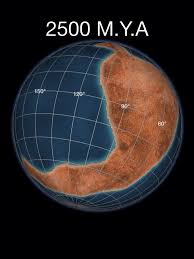ケノーランド大陸
ケノーランド大陸(ケノーランドたいりく、Kenorland)は、新太古代の27億2000万年前に形成されたと考えられている超大陸。のちのローレンシア大陸(現在の北アメリカとグリーンランドの核)・バルティカ大陸(現在のスカンジナビアとバルト海)・西オーストラリア・カラハリア陸塊で構成された[1]。新太古代の安定陸塊の付着成長と、大陸地殻の形成によって出来たと考えられている。

火成岩性岩脈と古地磁気、層序学上の研究分析などでこのプレート移動の再構成推定が可能になった。ケノーランドの中心であるバルト楯状地の痕跡は31億年前に遡る。イルガーン地塊(現在の西オーストラリア)には44億年前に遡るジルコン結晶が含まれる。
関連項目
編集参考文献
編集- Arestova, N. A.; Lobach-Zhuchenko, S. B.; Chekulaev, V. P.; Gus'kova, E. G. (2003). “Early Precambrian mafic rocks of the Fennoscandian shield as a reflection of plume magmatism: Geochemical types and formation stages”. Russian Journal of Earth Sciences 5 (3): 145–163. doi:10.2205/2003es000126 March 12, 2016閲覧。.
- Aspler, L. B.; Chiarenzilli, J. R.; Cousens, B. L.; Davis, W. J.; McNicoll, V. J.; Rainbird, R. H. (1999). “Intracratonic basin processes from breakup of Kenorland to assembly of Laurentia: new geochronology and models for Hurwitz Basin, Western Churchill Province”. Contributions to the Western Churchill NATMAP Project; Canada-Nunavut Geoscience Office March 12, 2016閲覧。.
- Halla, J. (2005). “Neoarchean sanukitoids (2.74–2.70 Ga)”. In Halla, J.; Nironen, M.; Lauri, L. S. et al.. Eurogranites 2005: Proterozoic and Archean Granites and Related Rocks of the Finnish Precambrian. University of Helsinki March 12, 2016閲覧。
- Mertanen, Satu (2004). Paleomagnetic Evidences for the Evolution of the Earth during Early Paleoproterozoic. Symposium EV04: Interaction of Endogenic, Exogenic and Biological Terrestrial Systems (PDF).
- Pesonen, L. J.; Elming, S.-Å.; Mertanen, S.; Pisarevsky, S.; D’Agrella-Filho, M. S.; Meert, J. G.; Schmidt, P. W.; Abrahamsen, N. et al. (2003). “Palaeomagnetic configuration of continents during the Proterozoic”. Tectonophysics 375 (1–4): 289–324. Bibcode: 2003Tectp.375..289P. doi:10.1016/s0040-1951(03)00343-3 March 12, 2016閲覧。.
出典
編集- ^ Pesonen et al. 2003, Abstract